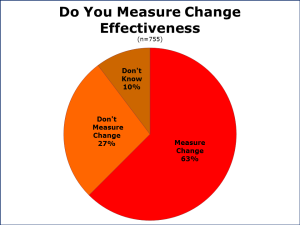
Most of our contributors do measure change, but 37% either don’t measure change or they don’t know if they do or feel measuring change is too difficult. So, here’s some evidence why this is worth struggling with. For example, learning is the most mentioned benefit of measuring change (27.1%). Yet, if this is so important then why the lack of focus on vehicles like coaching, mentoring and training to capitalize on this learning.[3]
Another striking disconnect is the low numbers of those who see benefits of measuring change’s impact on marketing and customers. This is curious, as our contributors’ most common reason for losing customers is not price but poor quality (92.2%), poor follow-up by sales people (76.5%) and making the wrong assumptions about customers (64.5%). After detailed analysis, it would seem that the relationship between change and competitive advantage is not as clearly visualized as one might think.
In addition, the use of employee metrics including personal performance, resistance to change, improvement to company culture and understanding our purpose, are low compared to satisfaction surveys. Most concerning is the lack of focus on individual behavioral change and tracking pay-related rewards. This is further evidence of little focus on accountability and establishing a requiring environment
Even when metrics are agreed upon, the next challenge is creating greater transparency so that they are used to create and sustain change momentum.
What Questions do Change Metrics Need to Answer?
Overall, there needs to be more focus on developing effective change metrics. The challenge is: How well do your change metrics accelerate learning, problem solving and decision making?
In Section 4, we distilled contributor questions on what they need change metrics to answer into a questionnaire. We ask readers to go through and rate their current metrics under three sections:
- Navigating during a Change
- Reviewing a Change
- Planning the Next Change
Our contributors suggest establishing a change scorecard with their leadership team and key stakeholders. For example by:
- Agreeing on those questions which the team needs to answer
- Deciding what current metrics could be put to good use
- Assessing during the change process how well they cover the risks of losing customers through poor product or service quality and poor sales follow-up.
And finally……Asking how well your scorecard helps you sell this and subsequent changes?
Action Points: Developing More Effective Change Metrics
Protocol
Three themes were referenced in contributor comments about change metrics and how to test their overall effectiveness.
- How well do your change metrics accelerate learning, problem-solving, and decision-making?
Establish Your Change Scorecard
It is strongly suggested that you go through this process with your leadership team and key stakeholders. (See section 7 for more details.)
- Review the table Contributor Questions.
- Agree on those questions your team need to answer when you are doing the following:
- Navigating a change
- Reviewing a change
- Planning the next change
- What current metrics could be put to good use?
- How well do they cover the risks of losing customers through poor-quality sales follow-up during the change process?
- How well do they inform you that the organization is reducing assumptions about customers’ view of the change and how the change responds to their needs?
- To what extent do your selected metrics allow you to preempt or least respond quickly to competitors
- How well do these metrics allow you to gauge and track employee stress around the change?
- To what extent will your metrics allow you to respond quickly and effectively to employee stress before it hardens their change resistance?
